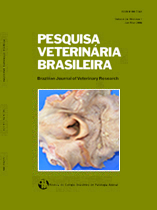 |
|
|
|
Year 2011 - Volume 31, Number 5
|

|
Anticoccidial activity of hydrochloric acid (HCl) against Eimeria tenella in broiler chickens, 31(5):425-429
|
ABSTRACT.- Abbas R.Z., Manzoor Z., Munawar S.H., Iqbal Z., Khan M.N., Saleemi M.K., Zia M.A. & Yousaf A. 2011. Anticoccidial activity of hydrochloric acid (HCl) against Eimeria tenella in broiler chickens. Pesquisa Veterinária Brasileira 31(5):425-429. Department of Parasitology, University of Agriculture, Faislabad - 38040, Pakistan. E-mail: raouaf@hotmail.com
The present study was planned to evaluate the anticoccidial activity of the different concentrations of the HCl against Eimeria tenella infection in broiler chickens in comparison with the amprolium anticoccidial. For this purpose, a total of 198 chicks were placed 11 per pen with three pens per treatment. The different concentrations of HCl (1000ppm, 2000ppm and 3000ppm) and amproilum (at the dose rate of 125ppm) were given to the experimental groups in drinking water from 10 to 19th days of age. One group was kept as infected non medicated control and one as non infected non medicated control. At the 12th day of age, all the groups were inoculated orally with 75,000 sporulated oocysts except non infected non medicated control. Anticoccidial activity was evaluated on the basis of performance (weight gain, feed conversion ratio) and pathogenic (oocyst score, lesion score and mortality %age) parameters. Among HCl medicated groups, the maximum anticoccidial effect was seen in the group medicated with 1000ppm HCl followed by 2000ppm and 3000ppm HCl medicated groups. Amprolium and 1000ppm HCl were almost equivalent in suppressing the negative performance and pathogenic effects associated with coccidiosis (Eimeria tenella) challenge. In summary, the lower doses of HCl have the potential to be used as alternative to chemotherapeutic drugs for Eimeria tenella control. It is therefore suggested that further studies should be carried out to determine the possible minimum safe levels of HCl with least toxic effects to be used as anticoccidial. |
| |
|
|
| |
|
 |